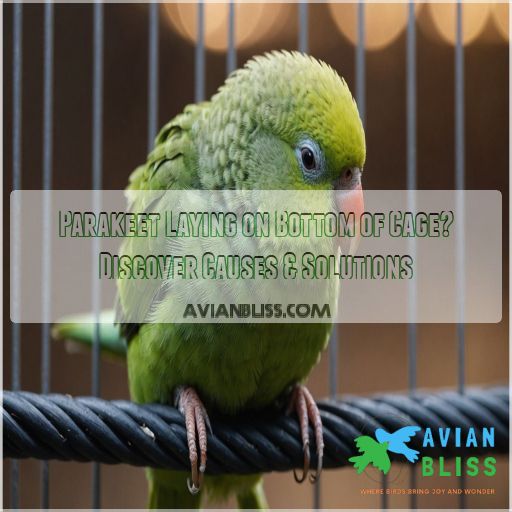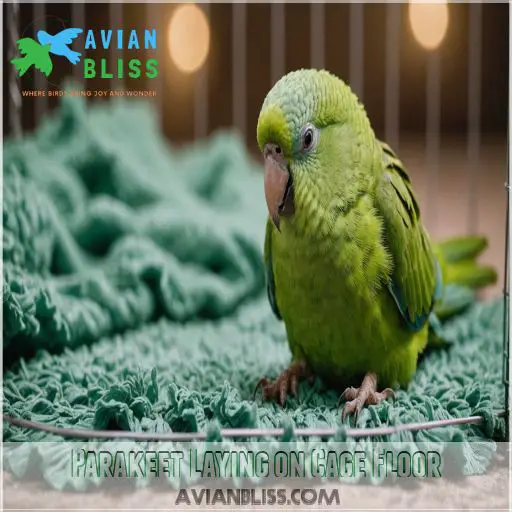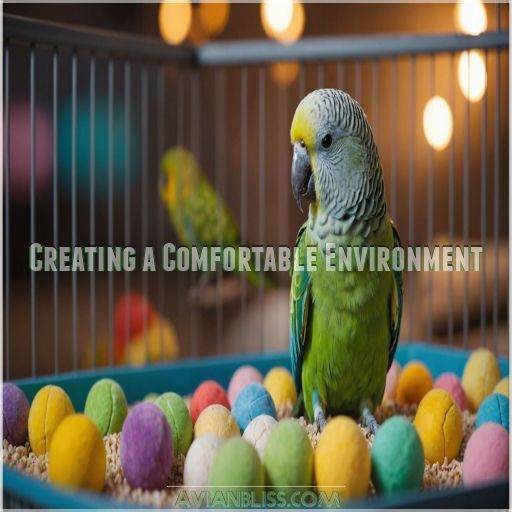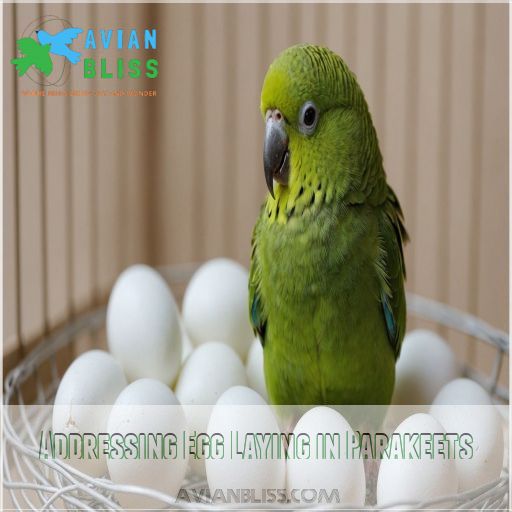This site is supported by our readers. We may earn a commission, at no cost to you, if you purchase through links.
 If your parakeet’s laying on the bottom of its cage, it might be signaling for help! There could be a few reasons for this curious behavior. Perhaps they’ve got a crush on the cage floor because they’re feeling under the weather or dealing with pesky egg-laying needs.
If your parakeet’s laying on the bottom of its cage, it might be signaling for help! There could be a few reasons for this curious behavior. Perhaps they’ve got a crush on the cage floor because they’re feeling under the weather or dealing with pesky egg-laying needs.
Stress, an uncomfortable cage setup, or hidden health issues can also make your feathery friend flat-out hit the floor.
Look for signs like fluffed feathers or droopy wings.
Creating a cozy environment and consulting an avian vet will help restore their perch. Stick around—there’s more to uncover about keeping your parakeet happy and healthy!
Table Of Contents
- Key Takeaways
- Parakeet Laying on Cage Floor
- Recognizing Parakeet Health Issues
- Parakeet Behavior and Body Language
- Creating a Comfortable Environment
- Addressing Egg Laying in Parakeets
- Frequently Asked Questions (FAQs)
- Why is my bird sleeping on the bottom of the cage?
- Is it normal for a parakeet to lay down?
- What would my bird sitting at the bottom of the cage fluffed up indicate?
- How can I tell if my parakeet is in pain?
- Can a parakeet die from lying on the bottom of the cage?
- Should I move my parakeet to a different cage if its on the bottom?
- How can I prevent my parakeet from getting sick?
- Is it normal for a parakeet to spend time on the bottom during molting?
- Can reproductive influences cause a parakeet to lie on the bottom of the cage?
- Conclusion
Key Takeaways
- If your parakeet is lounging on the cage floor, it’s like a bright red flag waving for attention – it might be stressed, sick, or even dealing with egg-laying issues. Dive into detective mode to uncover the clues and act promptly.
- Spotting your bird fluffed up with droopy wings or refusing its favorite snack? These aren’t casual moves; they’re more like an SOS. It’s time to consult an avian vet and nip any potential health problems in the bud.
- Egg-laying can turn your parakeet’s life into an unexpected roller coaster. No need to freak out. With a few dietary tweaks and cozy environment changes, you can keep things smooth sailing for your feathered friend.
- A spacious, safe cage is your parakeet’s happy place – think of it as their own castle. Regular checkups, fresh food, engaging toys, and the right lighting can help prevent your bird from becoming a cage-bottom dweller.
Parakeet Laying on Cage Floor
If you find your parakeet laying on the cage floor, it might feel like discovering a secret stash of candy in the pantry, only less joyful.
Understanding this behavior is important as it can indicate issues like discomfort, pain, or egg-laying needs, all of which require thoughtful attention to create a safe and nurturing environment.
Reasons for Laying on Cage Floor
Finding your parakeet lounging on the cage floor might seem like a lazy Sunday, but it’s often a sign of stress, lack of nesting materials, improper cage size, or potential health issues.
Signs of Discomfort or Pain
If your parakeet is fluffed up, lethargic, or has drooping wings and a loss of appetite, it may be in discomfort or pain.
Pay close attention and consult an avian vet.
Connection to Egg Laying
Parakeets lying on the cage floor might be dealing with hormonal triggers related to egg laying.
Consider these factors:
- Breeding season
- Nest box size
- Dietary influence
- Environmental factors
Importance of a Suitable Environment
Without the right environment, egg laying issues persist. Imagine your home missing essentials. Provide a spacious cage, cozy nest box, stable temperature, peaceful spot, and proper lighting for happier budgies.
Recognizing Parakeet Health Issues
If you’re worried about your parakeet hanging out on the cage floor, it’s time to brush up on their health check routine.
Understanding common health issues in parakeets helps you spot early signs of illness or injury and keeps your feathered friend in excellent condition.
Common Health Issues in Parakeets
From respiratory troubles to foot issues, parakeets can face a variety of common health concerns. Stay vigilant and consult an avian vet to keep your feathered friend happy and healthy.
Signs of Illness or Injury
Spot feather plucking? Notice some lethargy or maybe loss of appetite? These might signal illness.
Swollen feet or breathing difficulties are more red flags to watch for ensuring your parakeet’s comfort.
Importance of Veterinary Care
So, you’ve spotted some signs of illness. Here’s why you should consider veterinary care:
- Avian specialists can assess health concerns.
- Routine checkups.
- Emergency situations.
- Preventative care before it’s too late.
Preventative Measures for a Healthy Parakeet
After your vet visit, make sure your parakeet stays healthy with balanced nutrition, regular cage safety checks, and socialization.
Reduce stress like a Zen master, and watch your feathered friend’s happiness soar sky-high!
Parakeet Behavior and Body Language
Parakeets are fascinating little birds with a wide range of behaviors and body language.
From chirping happily to fluffing up their feathers when stressed, understanding your parakeet’s cues can help you create a comfortable, enriching environment for your feathered friend.
Understanding Parakeet Behavior
Understanding parakeet behavior is key. Their chirps, dances, and head bobs are like text messages. Each action whispers secrets about their mood, social needs, or desire for parakeet-to-human bonding.
Recognizing Stress or Anxiety
Is your parakeet in a pickle with stress or anxiety? Look for signs like:
- Feather plucking
- Shivering
- Quiet behavior
If they lose their appetite, it’s time for action!
Signs of Contentment or Happiness
You’ve tackled stress and anxiety; now, let’s explore contentment.
A playful parakeet chirps joyfully, preens feathers, eats heartily, and sleeps soundly, painting a picture of happiness, like sunshine on a cloudy day.
Importance of Social Interaction
As social creatures, parakeets thrive on interaction. Engage your feathered friend through playtime, training, and allowing them to bond with their flock – a recipe for a happy, well-adjusted pet.
Creating a Comfortable Environment
Creating a comfy environment for your parakeet isn’t just about decor; it’s about making your feathered friend feel at home.
With the right cage size, fun perches, safe surroundings, and perfect lighting, you’ll make sure your bird’s got a place that’s the cat’s pajamas—without any actual cats around!
Cage Size and Layout
When parakeets feel like sardines in a tin can, that’s trouble brewing.
Opt for a spacious cage—think avian mansion!—where they can flutter freely, ensuring cleanliness and safety for peaceful birdie bliss.
Providing Adequate Perches and Toys
Perches and toys are key to a parakeet’s happiness. Remember these tips:
- Use natural branches.
- Make sure toys are safe.
- Rotate toys regularly.
- Boost engagement with fresh enrichment ideas.
Maintaining a Clean and Safe Environment
Keep your parakeet’s cage spotless by scrubbing perches, replacing litter, and disinfecting toys regularly.
Make sure food and water are fresh to prevent illness.
A clean, safe home keeps your feathered friend happy and healthy.
Importance of Proper Lighting and Temperature
Getting lighting and temperature right is really important.
Your parakeet prefers sunny, warm spots, much like a beachgoer.
Proper settings promote health, prevent unwanted behavior, and make sure breeding efforts don’t fizzle out.
Addressing Egg Laying in Parakeets
If your parakeet is laying eggs, don’t panic—you’re not the only one dealing with a feathery fertility frenzy!
Learn how to tweak their diet and environment to prevent them from becoming egg-laying machines, and remember, sometimes a trip to the vet is just the ticket for keeping your bird healthy and happy.
Causes of Egg Laying in Parakeets
Understanding why your parakeet might lay eggs can feel like a roller coaster. Causes include:
- Hormonal imbalance during breeding season.
- Age and diet factors.
- Stress from environmental changes.
Dietary Adjustments to Prevent Egg Laying
Adjust your parakeet’s diet to curb egg-laying. Opt for a seed-free, veggie-rich menu, and time meals strategically. Supplements like calcium can also help maintain proper nutrition.
Environmental Modifications to Prevent Egg Laying
To prevent egg-laying, remove nesting materials and create a cage size that discourages it. Limit cagemate interaction, and adjust the lighting schedule. Choose toys wisely to avoid nesting behavior.
Importance of Veterinary Care for Egg Laying Issues
When your parakeet’s egg-laying seems like watching a never-ending sitcom, an avian vet’s expertise is really important.
They can help with:
- Egg binding
- Yolk peritonitis
- Hormonal treatments
Seek guidance promptly!
Frequently Asked Questions (FAQs)
Why is my bird sleeping on the bottom of the cage?
It’s possible your bird’s under the weather if it’s nesting on the cage floor.
"Out of the blue" behavior like this might indicate illness, discomfort, or just seeking a cozy spot.
Check with a vet.
Is it normal for a parakeet to lay down?
Parakeets usually perch, not lay flat.
Seeing your parakeet lying down can raise red flags.
Think of it as your bird’s way of waving a little white flag that something’s amiss—often signaling illness or stress.
What would my bird sitting at the bottom of the cage fluffed up indicate?
Fluffing up and sitting at the bottom of the cage can be alarming, signaling stress or illness in your bird.
Imagine a bird feeling under the weather; it might need warmth or quiet, like you during a cold.
How can I tell if my parakeet is in pain?
If your parakeet is in pain, you may notice it favoring one foot, refusing to eat, or acting lethargic.
Don’t hesitate to take it to the vet for a proper diagnosis and treatment.
Can a parakeet die from lying on the bottom of the cage?
Imagine the bottom of the cage as a red flag.
It’s not normal for a parakeet to lounge there.
While not immediately deadly, it can signal illness or distress.
Keep a close eye and consider a vet visit.
Should I move my parakeet to a different cage if its on the bottom?
You’ve got your parakeet on the bottom of its cage? That’s its way of telling you something’s up.
Best to move it to a new cage if it seems stressed.
Always keep an eye on it.
How can I prevent my parakeet from getting sick?
Keep your parakeet healthy by ensuring a balanced diet with fresh greens, maintaining a warm, dry environment, and providing toys for mental stimulation.
Regular vet check-ups also help catch issues before they become full-blown squawks.
Is it normal for a parakeet to spend time on the bottom during molting?
As your feathered friend molts, they may feel a bit under the weather, so don’t be surprised to find them taking a load off on the cage floor.
Just keep an eye on them and make sure they’re staying hydrated.
Can reproductive influences cause a parakeet to lie on the bottom of the cage?
Reproductive influences can cause a parakeet to lie on the cage bottom, potentially indicating an underlying illness.
Females may nestle there during egg-laying, indicating pregnancy.
Complications like egg-binding require attention, as health and well-being rely heavily on keen observation and timely intervention.
Conclusion
Picture your parakeet as a tiny feathered detective, using their position at the bottom of the cage as a clue to solve the mystery of their discomfort.
When your parakeet’s laying on the bottom of its cage, it’s a call to action.
By understanding potential causes and solutions like stress, health issues, or egg laying, you can create a haven of health and happiness for your bird.
Consult an avian vet to catch those hidden clues early!








